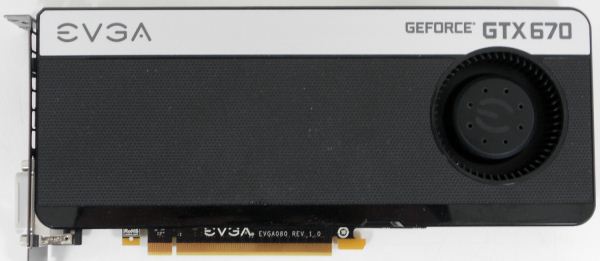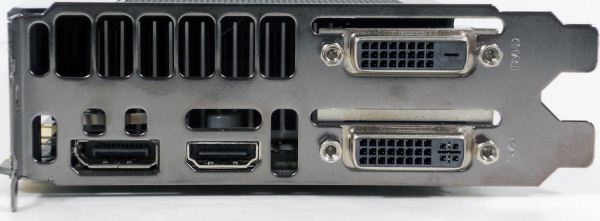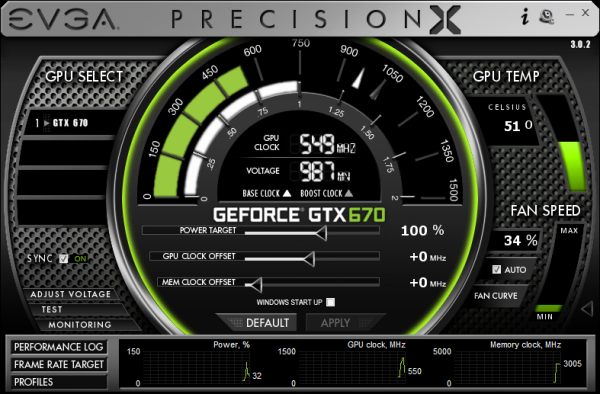NVIDIA GeForce GTX 670 Review Feat. EVGA: Bringing GK104 Down To $400
by Ryan Smith on May 10, 2012 9:00 AM ESTMeet The EVGA GeForce GTX 670 Superclocked
Our second card of the day is EVGA’s GeForce GTX 670 Superclocked, which in EVGA’s hierarchy is their first tier of factory overclocked cards. EVGA is binning GTX 670s and in turn promoting some of them to this tier, which means the GTX 670 Superclocked are equipped with generally better performing chips than the average reference card.
| GeForce GTX 670 Partner Card Specification Comparison | ||||
| EVGA GeForce GTX 670 Superclocked | GeForce GTX 670 (Ref) | |||
| CUDA Cores | 1344 | 1344 | ||
| Texture Units | 112 | 112 | ||
| ROPs | 32 | 32 | ||
| Base Clock | 967MHz | 915MHz | ||
| Boost Clock | 1046MHz | 980MHz | ||
| Memory Clock | 6210MHz | 6008MHz | ||
| Memory Bus Width | 256-bit | 256-bit | ||
| Frame Buffer | 2GB | 2GB | ||
| TDP | 170W | 170W | ||
| Manufacturing Process | TSMC 28nm | TSMC 28nm | ||
| Width | Double Slot | Double Slot | ||
| Length | 9.5" | 9.5" | ||
| Warranty | 3 Years | N/A | ||
| Price Point | $419 | $399 | ||
For the GTX 670 SC, EVGA has given both the core clock and memory clock a moderate boost. The core clock has been increased by 52MHz (6%) to 967MHz base and 66MHz (7%) boost to 1046MHz. Meanwhile the memory clock has been increased by 202MHz (3%) to 6210MHz.
Other than the clockspeed changes, the GTX 670 SC is an almost-reference card utilizing a reference PCB with a slightly modified cooler. EVGA is fabricating their own shroud, but they’ve copied NVIDIA’s reference shroud down to almost the last detail. The only functional difference is that the diameter of the fan intake is about 5mm less, otherwise the only difference is that EVGA has detailed it differently than NVIDIA and used some rounded corners in place of square corners.
The only other change you’ll notice is that EVGA is using their own high flow bracket in place of NVIDIA’s bracket. The high flow bracket cuts away as much metal as possible, maximizing the area of the vents. Though based on our power and temperature readings, this doesn’t seem to have notably impacted the GTX 670 SC.
While we’re on the matter of customized cards and factory overclocks, it’s worth reiterating NVIDIA’s position on factory overclocked cards. Reference and semi-custom cards (that is, cards using the reference PCB) must adhere to NVIDIA’s power target limits. For GTX 670 this is a 141W power target, with a maximum power target of 122% (170W). Fully custom cards with better power delivery circuitry can go higher, but not semi-custom cards. As a result the flexibility in building semi-custom cards comes down to binning. EVGA can bin better chips and use them in cards such as the Superclocked – such as our sample which can go 17 boost bins over the base clock versus 13 bins for our reference GTX 670 – but at the end of the day for stock performance they’re at the mercy of what can be accomplished within 141W/170W.
In any case, as the card is otherwise a reference GTX 670 EVGA is relying on the combination of their factory overclock, their toolset, and their strong reputation for support to carry the card. EVGA has priced the card at $419, $20 over the GTX 670 MSRP, in-line with other factory overclocked cards.
On the subject of pricing and warranties, since this is the first EVGA card we’ve reviewed since April 1st, this is a good time to go over the recent warranty changes EVGA has made.
Starting April 1st, EVGA has implemented what they’re calling their new Global Warranty Policy. Starting July 1st, 2011 (the policy is being backdated), all new EVGA cards ship with at least a 3 year warranty. And for the GTX 600 series specifically, so far EVGA has only offered models with a 3 year warranty in North America, which simplifies their product lineup.
To complement the 3 year warranty and replace the lack of longer term warranties, EVGA is now directly selling 2 and 7 year warranty extensions, for a total of 5 and 10 years respectively. So instead of buying a card with a 3 year warranty or a longer warranty, you’ll simply buy the 3 year card and then buy a warranty extension to go with it. However the extended warranty requires that the card be registered and the warranty purchased within 30 days.
The second change is that the base 3 year warranty no longer requires product registration. EVGA has other ways to entice buyers into registering, but they’ll now honor all applicable cards for 3 years regardless of the registration status. At the same time the base 3 year warranty is now a per-product warranty (e.g. a transferable warranty) rather than per-user warranty, so the base warranty will transfer to 2nd hand buyers. The extended warranties however will not.
The third change is how EVGA is actually going to handle the warranty process. First and foremost, EVGA is now allowing cards to be sent to the nearest EVGA RMA office rather than the office for the region the card was purchased from. For example a buyer moving from Europe to North America can send the card to EVGA’s North American offices rather than sending it overseas.
Finally, EVGA is now doing free cross shipping, alongside their existing Advanced RMA program. EVGA will now cross-ship replacement cards for free to buyers. The buyer meanwhile is responsible for paying to ship the faulty card back and putting up collateral on the new card until EVGA receives the old card.
There’s also one quick change to the step-up program that will impact some customers. With the move to purchasing extended warranties, the step-up program is only available to customers who either purchase an extended warranty or purchase an older generation card that comes with a lifetime warranty. Step-up is not available to cards with only the base 3 year warranty.
Moving on, along with EVGA’s new warranty EVGA is bundling the latest version of their GPU utilities, Precision X and OC Scanner X.
Precision X, as we touched upon quickly in our GTX 680 review, is the latest iteration of EVGA’s Precision overclocking & monitoring utility. It’s still based on RivaTuner and along with adding support for the GTX 600 series features (power targets, framerate caps, etc), it also introduces a new UI. Functionality wise it’s still at the top of the pack along with the similarly RivaTuner powered MSI Afterburner. Personally I’m not a fan of the new UI – circular UIs and sliders aren’t particularly easy to read – but it gets the job done.
OC Scanner X has also received a facelift and functionality upgrade of its own. Along with its basic FurMark-ish stress testing and error checking, it now also offers a basic CPU stress test and GPU benchmark.



















414 Comments
View All Comments
chizow - Sunday, May 13, 2012 - link
For shame...once again you fail horribly, once you're done cherrypicking individual benchmarks you'll see Fermi does outclass Tesla by close to 100%, especially once AA is enabled:
http://www.anandtech.com/bench/Product/317?vs=305
Feel free to also compare to techpowerup or computerbase compilations to see similar results, since you obviously haven't been following the industry long enough to experience these revolutionary upgrades first-hand.
This is all common knowledge to GPU enthusiasts though, including the author of this article. Please update your frame of reference before you comment further. Thanks.
CeriseCogburn - Sunday, May 13, 2012 - link
Cherry picking is this very site and using the firswt bench at every release page CRYSIS your favorite amd game right now ?Cherry picking when the SAME VENDOR CARD nVidia is used ?
Now nVidia is against itself in Crysis, and that's cherry picking ? I used the first game to actually look, because all we've has otherwise is you and your amd fanboys flapping lips... with ZERO evidence...
Now I'll look at your stupid link which is ZERO EVIDENCE for now since you cannot even be beyond lazy and copy a bit of text from it or claim what you think it proves.
LOL - so it proves nothing right ? You've got nothing. You have failed.
CeriseCogburn - Sunday, May 13, 2012 - link
" ince you obviously haven't been following the industry long enough to experience these revolutionary upgrades first-hand. "Dude, I have been following daily for likely more years than your age.
Good luck with that stupidity.
80% and 75% is crap.
33% down to 20% or so is fine, but we have another problem - the GTX580 was an enormous movement in total as it was tacked on improved after the 480 and was just prior distorting your tiny moaning brain, as you add on your ten years blabbering talking point with your long time amd fanboyism to bolster it.
It took me a few minutes to prove you lied. :)
You've got a bit of a point, but not much, and the added features of this new nVidia release ( adaptive v-sync, frame rate target (precisionX) ) negates all of that anyway - not to mention the driver add going all the way back to the 8 series.
You're just moaning for no reason and lying too much while doing it.
Iketh - Thursday, May 10, 2012 - link
your logic is flawed beyond beliefchizow - Thursday, May 10, 2012 - link
Really? How so? If it was so flawed it should be simple for someone so clever as you to poke it full of holes.I'm waiting. :/
CeriseCogburn - Saturday, May 12, 2012 - link
Here's a hole so large you'll be moaning when I'm done, and not about pricing or performance increase.A lot of people may wait a couple generations to upgrade, or go from a top tier card 2 or 3 gen back to a secondary card now new - or vise versa, cross over the big two, etc. etc.
In your retentive and specialized moaning, you've restricted end user reality to a single specific instance you've handily outlined as your only metric, and have declared your single path to be the only qualifying upgrade doctrine to use.
Now there's a zeal of rectal tightness one can easily surmise no end user gaming enthusiast has ever adhered to in their purchasing history, in the entire world, not once, ever.
So what we really have is a much varied user base in the card(s) they currently run, and a quite varied distane and jump, node, architecture, two cards to one, one card to two, using a current card as a PhysX boost for a hot and cheap upgrade, etc.
Thus, a person can wait out the $499 nVidia flagship launch or one or two, or some in between node shrink G80 to G92b, 280 to 285, 470 or 480 to 580, etc, and make the jump NOT when your choice choking and frankly stupid single choice only stroke my moaning firebrand demanded purchase scenario rears it's stupid dead head.
In other words, the $499 you complain about is not the second $499 the real gamer and end user customer spent, they've been sitting a round, and are only spending once, not on your miniscule upgrade single purchase own only before and after rant line....
So people figure it out in spite of your complaining, and make an enormous jump in their upgrade, or sell off a sli of cf set and barely spend a dime for a good "reset" for a future dual card perf bump on the cheap, or take the second or third or prior tier for a spin with a healthy discount from the release you hate with passion so much.
You see, you've become a one trick pony, the one trick an amd fanboy can rage about and pretend to have a point - now I wouldn't mind so much if your 75% and 80% crap wasn't so obviously a doubly inflated lie - but on the other hand the initial constraint you introduce is near worthless for any current end user your hoped for perfectly having a fit scenario would apply to !. -
NOTE: I'm so close to current performance because in the last ten years of those wonderful and enormous increases chizow has so adeptly been gassing the entire room about in hyper ventilation, that I think I'll keep my recently purchased flagship(s) that enjoyed not long ago that great and gigantic leap of power chizow loves in his tiny red heart so much ! Thanks chizow ! I can sit here a big fat winner with all my money in my pocket and it's such a poor increase I am win still for zero dollars !
See how that works genius ? :-)
SlyNine - Saturday, May 12, 2012 - link
Your constant use of twisted circular logic is amusing.CeriseCogburn - Sunday, May 13, 2012 - link
That's no rebuttal at all. We'll go with you and your chizow pal's upgrade path right - the one and only you and he allow for your argument ... that's not twisted..(rolls eyes)
CeriseCogburn - Sunday, May 13, 2012 - link
You're actually a person who did exactly what I said SlyNine, you're perfect personal proof, as you have more than once stated you went from 5870 and jumped 2 flagship releases and bought the 680.Now, even after personally doing this, you attack my explanation calling it circular logic.
Look in the mirror amd fanboy. I am sorry your amd fanboy base lifestyle took an upset this round, and you personally decided 7970 sucked compared to 680, and jumped from your 5870.
You obviously couldn't bring yourself to move to the small performance increase the just prior 6970 was, slapping chizow with that brick unconsciously, you attack me, the person who correctly outlined what actually occurs, that you actually did, by your own words, elsewhere more than once, in these posts.
ROFL - you really, really, really blew it badly that time Slynine.
BulletSpongeRTR - Thursday, May 10, 2012 - link
Exactly, I'm a lowly line cook for a large restaurant chain making $10/hr. But I have SAVED my pennies for this card and will be ordering one today. If an individual cannot reign in their expenses and put away a little here and there to buy what they want (and lets be honest, a 670 is a want NOT a NEED) then they should not be complaining. I'm nearly done acquiring parts for my first build and will be glad when it's done. One more "Summer if Ramen" is all I can do.